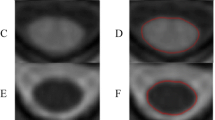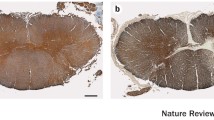Abstract
Introduction
The potential of diffusion tensor imaging (DTI) to detect spinal cord abnormalities in patients with multiple sclerosis has already been demonstrated. The objective of this study was to apply DTI techniques to multiple sclerosis patients with a recently diagnosed spinal cord lesion, in order to demonstrate a correlation between variations of DTI parameters and clinical outcome, and to try to identify DTI parameters predictive of outcome.
Methods
A prospective single-centre study of patients with spinal cord relapse treated by intravenous steroid therapy was made. Patients were assessed clinically and by conventional MRI with DTI sequences at baseline and at 3 months.
Results
Sixteen patients were recruited. At 3 months, 12 patients were clinically improved. All but one patient had lower fractional anisotropy (FA) and apparent diffusion coefficient (ADC) values than normal subjects in either inflammatory lesions or normal-appearing spinal cord. Patients who improved at 3 months presented a significant reduction in the radial diffusivity (p = 0.05) in lesions during the follow-up period. They also had a significant reduction in the mean ADC (p = 0.002), axial diffusivity (p = 0.02), radial diffusivity (p = 0.02) and a significant increase in FA values (p = 0.02) in normal-appearing spinal cord. Patients in whom the American Spinal Injury Association sensory score improved at 3 months showed a significantly higher FA (p = 0.009) and lower radial diffusivity (p = 0.04) in inflammatory lesion at baseline compared to patients with no improvement.
Conclusion
DTI MRI detects more extensive abnormalities than conventional T2 MRI. A less marked decrease in FA value and more marked decreased in radial diffusivity inside the inflammatory lesion were associated with better outcome.

Similar content being viewed by others
References
Ikuta F, Zimmerman HM (1976) Distribution of plaques in seventy autopsy cases of multiple sclerosis in the United States. Neurology 26:26–28
Hittmair K, Mallek R, Prayer D, Schindler EG, Kollegger H (1996) Spinal cord lesions in patients with multiple sclerosis: comparison of MR pulse sequences. AJNR Am J Neuroradiol 17:1555–1565
Kidd D, Thorpe JW, Thompson AJ, Kendall BE, Moseley IF, MacManus DG et al (1993) Spinal cord MRI using multi-array coils and fast spin echo. II. Findings in multiple sclerosis. Neurology 43:2632–2637
Nijeholt GJ, van Walderveen MA, Castelijns JA, van Waesberghe JH, Polman C, Scheltens P et al (1998) Brain and spinal cord abnormalities in multiple sclerosis. Correlation between MRI parameters, clinical subtypes and symptoms. Brain 121:687–697
Rocca MA, Mastronardo G, Horsfield MA, Pereira C, Iannucci G, Colombo B et al (1999) Comparison of three MR sequences for the detection of cervical cord lesions in patients with multiple sclerosis. AJNR Am J Neuroradiol 20:1710–1716
Stevenson VL, Leary SM, Losseff NA, Parker GJ, Barker GJ, Husmani Y et al (1998) Spinal cord atrophy and disability in MS: a longitudinal study. Neurology 51:234–238
Tartaglino LM, Friedman DP, Flanders AE, Lublin FD, Knobler RL, Liem M (1995) Multiple sclerosis in the spinal cord: MR appearance and correlation with clinical parameters. Radiology 195:725–732
Pierpaoli C, Basser PJ (1996) Toward a quantitative assessment of diffusion anisotropy. Magn Reson Med 36:893–906
Agosta F, Absinta M, Sormani MP, Ghezzi A, Bertolotto A, Montanari E et al (2007) In vivo assessment of cervical cord damage in MS patients: a longitudinal diffusion tensor MRI study. Brain 130:2211–2219
Ciccarelli O, Wheeler-Kingshott CA, McLean MA, Cercignani M, Wimpey K, Miller DH et al (2007) Spinal cord spectroscopy and diffusion-based tractography to assess acute disability in multiple sclerosis. Brain 130:2220–2231
Renoux J, Facon D, Fillard P, Huynh I, Lasjaunias P, Ducreux D (2006) MR diffusion tensor imaging and fiber tracking in inflammatory diseases of the spinal cord. AJNR Am J Neuroradiol 27:1947–1951
Valsasina P, Rocca MA, Agosta F, Benedetti B, Horsfield MA, Gallo A et al (2005) Mean diffusivity and fractional anisotropy histogram analysis of the cervical cord in MS patients. NeuroImage 26:822–828
Freund P, Wheeler-Kingshott C, Jackson J, Miller D, Thompson A, Ciccarelli O (2010) Recovery after spinal cord relapse in multiple sclerosis is predicted by radial diffusivity. Mult Scler 16:1193–1202
Polman CH, Reingold SC, Edan G, Filippi M, Hartung HP, Kappos L et al (2005) Diagnostic criteria for multiple sclerosis: 2005 revisions to the “McDonald Criteria”. Ann Neurol 58:840–846
Kurtzke JF (1983) Rating neurologic impairment in multiple sclerosis: an expanded disability status scale (EDSS). Neurology 33:1444–1452
Paraplegia. ASIAIMSo (1992) International standards for neurological and functional classification of spinal cord injury patients (Revised). American Spinal Injury Association, Chicago
Ducreux D, Nasser G, Lacroix C, Adams D, Lasjaunias P (2005) MR diffusion tensor imaging, fiber tracking, and single-voxel spectroscopy findings in an unusual MELAS case. AJNR Am J Neuroradiol 26:1840–1844
Haselgrove JC, Moore JR (1996) Correction for distortion of echo-planar images used to calculate the apparent diffusion coefficient. Magn Reson Med 36:960–964
Budde MD, Xie M, Cross AH, Song SK (2009) Axial diffusivity is the primary correlate of axonal injury in the experimental autoimmune encephalomyelitis spinal cord: a quantitative pixelwise analysis. J Neurosci 29:2805–2813
Feng S, Hong Y, Zhou Z, Jinsong Z, Xiaofeng D, Zaizhong W et al (2009) Monitoring of acute axonal injury in the swine spinal cord with EAE by diffusion tensor imaging. J Magn Reson Imaging 30:277–285
Kim JH, Budde MD, Liang HF, Klein RS, Russell JH, Cross AH et al (2006) Detecting axon damage in spinal cord from a mouse model of multiple sclerosis. Neurobiol Dis 21:626–632
Ou X, Sun SW, Liang HF, Song SK, Gochberg DF (2009) The MT pool size ratio and the DTI radial diffusivity may reflect the myelination in shiverer and control mice. NMR Biomed 22:480–487
Sun SW, Liang HF, Trinkaus K, Cross AH, Armstrong RC, Song SK (2006) Noninvasive detection of cuprizone induced axonal damage and demyelination in the mouse corpus callosum. Magn Reson Med 55:302–308
Zhang J, Jones M, DeBoy CA, Reich DS, Farrell JA, Hoffman PN et al (2009) Diffusion tensor magnetic resonance imaging of Wallerian degeneration in rat spinal cord after dorsal root axotomy. J Neurosci 29:3160–3171
DeBoy CA, Zhang J, Dike S, Shats I, Jones M, Reich DS et al (2007) High resolution diffusion tensor imaging of axonal damage in focal inflammatory and demyelinating lesions in rat spinal cord. Brain 130:2199–2210
Nijeholt GJ, Bergers E, Kamphorst W, Bot J, Nicolay K, Castelijns JA et al (2001) Post-mortem high-resolution MRI of the spinal cord in multiple sclerosis: a correlative study with conventional MRI, histopathology and clinical phenotype. Brain 124:154–166
Henderson AP, Barnett MH, Parratt JD, Prineas JW (2009) Multiple sclerosis: distribution of inflammatory cells in newly forming lesions. Ann Neurol 66:739–753
Tallantyre EC, Bo L, Al-Rawashdeh O, Owens T, Polman CH, Lowe JS et al (2010) Clinico-pathological evidence that axonal loss underlies disability in progressive multiple sclerosis. Mult Scler 16:406–411
Song SK, Yoshino J, Le TQ, Lin SJ, Sun SW, Cross AH et al (2005) Demyelination increases radial diffusivity in corpus callosum of mouse brain. NeuroImage 26:132–140
Naismith RT, Xu J, Tutlam NT, Lancia S, Trinkaus K, Song SK et al (2012) Diffusion tensor imaging in acute optic neuropathies: predictor of clinical outcomes. Arch Neurol 69:65–71
Naismith RT, Xu J, Tutlam NT, Scully PT, Trinkaus K, Snyder AZ et al (2010) Increased diffusivity in acute multiple sclerosis lesions predicts risk of black hole. Neurology 74:1694–1701
Miller DH, Weinshenker BG, Filippi M, Banwell BL, Cohen JA, Freedman MS et al (2008) Differential diagnosis of suspected multiple sclerosis: a consensus approach. Mult Scler 14:1157–1174
Agosta F, Benedetti B, Rocca MA, Valsasina P, Rovaris M, Comi G et al (2005) Quantification of cervical cord pathology in primary progressive MS using diffusion tensor MRI. Neurology 64:631–635
Conflict of interest
We declare that we have no conflict of interest.
Author information
Authors and Affiliations
Corresponding author
Rights and permissions
About this article
Cite this article
Théaudin, M., Saliou, G., Ducot, B. et al. Short-term evolution of spinal cord damage in multiple sclerosis: a diffusion tensor MRI study. Neuroradiology 54, 1171–1178 (2012). https://doi.org/10.1007/s00234-012-1057-1
Received:
Accepted:
Published:
Issue Date:
DOI: https://doi.org/10.1007/s00234-012-1057-1




